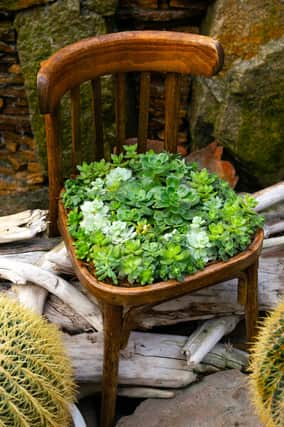Going Green - How to make your garden furniture more eco-friendly


Latest article from Angela Terry
Green Green campaigner and consumer expert, Angela Terry, separates climate change facts from fiction and here she explains how you can take simple, practical steps to help save the planet. Follow @ouronehome & visit https://onehome.org.uk/ for more advice.
Q: How do I choose eco-friendly garden furniture?
A: Garden furniture is designed so you can enjoy the great outdoors in comfort. But if it’s not made sustainably, then it can negatively impact on nature. Here are my tips for making an environmentally-sound choice:
Make it a long-term investment
In summer, we spend more time outdoors, so investing in good quality, sustainable garden furniture is a bright idea. Cheap and lightweight plastic furniture frequently needs replacing, causing unnecessary environmental harm. Buying better quality, hard-wearing items is a long-term investment. The longer it lasts, the better it is for the planet. And if you can still use your old furniture set, but fancy a change, then perhaps buy new cushions instead?
Go for sustainable materials
Advertisement
Hide AdAdvertisement
Hide AdGarden furniture is often made of problematic materials. Rattan seats are extremely popular at the moment but tend to be made of plastic and can’t be recycled. This means they’ll end up in landfill. Metal furniture, such as tables and chairs made from aluminium, uses a huge amount of energy to produce. So what is the solution?
Wood is the best choice. It’s renewable and can be easily repurposed or recycled. There is a wide range of products made from both softwoods, such as pine, and hardwoods, such as oak, so this choice mainly comes down to your budget. Look out for furniture with the Forest Stewardship Council (FSC) logo, which means it’s made from responsibly-managed woodlands. Also, consider where the wood comes from. Buy European if you can.
That being said, bamboo – largely grown in Asia, sub-Saharan Africa, Australia and the Americas – is also a sustainable choice. It needs less water to grow than conventional timber and also grows very fast – sometimes nearly a metre a day!
Care for your furniture


Rain can lead to mould and rust, while heavy winds can blow furniture over and cause breakages. Without proper care, garden furniture will need to be replaced more frequently. To make it last, take good care of your furniture – oiling wood, fixing breaks and covering it when it rains.
Shop ethically
Advertisement
Hide AdAdvertisement
Hide AdIf it’s time to replace your garden furniture, you could shop second-hand. You can find real bargains! The websites Preloved, Facebook Marketplace and Gumtree are good places to start. If you can’t find anything suitable and decide to shop for something new, you could look online at Sustainable Furniture, Iron Fire and Chunky Reclaimed Furniture. On the high street, you can buy FSC accredited garden furniture in Aldi, Asda, John Lewis and Robert Dyas.
Celebrity spot
Music legend Kate Bush’s multi-million pound mansion is hanging on a cliff edge because of climate change.


The Running up that Hill singer’s home is perched on a Devon clifftop.
Unfortunately, it’s getting closer to the edge due to coastal erosion, which is getting worse because of the climate crisis.
Advertisement
Hide AdAdvertisement
Hide AdCliffs are crumbling faster because of sea level rise and an increase in storms. The local council’s advice is that Kate herself intervenes– by spraying the cliff with concrete – or accept her home will fall into the sea.
Green swap
Try taking a train instead of a flight, especially if not going far.


Difference in emissions is staggering.
For example, 90 per cent less if taking Eurostar instead London to Paris. Visit website ecopassenger.org to make the comparison for your journey.
How you can have a no-fly holiday anytime


We’ve become used to cheap flights and hopping over to Europe – well, certainly before COVID-19!
Advertisement
Hide AdAdvertisement
Hide AdYet, the truth is that flying is the most environmentally destructive mode of travel. And, what with all the airport disruptions, there are alternatives that are definitely worth exploring.
Here are some ideas you may like to consider ...
Staycations in the UK
The UK has it all: there are some beautiful beaches, there are some gorgeous coastal towns, there is some stunning countryside, there are vibrant cities and there are also some world-famous historic sights.
For example, have you seen the dramatic landscapes of the Isle of Skye, or the picture postcard villages of the Cotswolds or even the jaw-dropping views of the Glamorgan Heritage Coast?
Also, have you experienced the amazing food and drink scenes of Glasgow’s quirky West End and Brighton’s buzzing Lanes?
Advertisement
Hide AdAdvertisement
Hide AdThere are so many options for fantastic UK-based holidays, why not give one a go?
Rail travel to Europe
We really are on Europe’s doorstep. Thanks to Eurostar, you can travel by train from London to Paris in under three hours.
The journey to Brussels takes under two hours, while Amsterdam is less than four hours away.
From all of these cities, you can then take sleeper trains across the continent.
Advertisement
Hide AdAdvertisement
Hide AdFor example, you can travel overnight from Paris to Milan, or from Brussels to Vienna or from Amsterdam to Innsbruck.
You could treat yourself to the luxury of a sleeper cabin.
A more affordable way to get some kip is to book a bunk called a ‘couchette’.
Even better, you can book your entire journey on the Trainline website.
Beach lovers fear not! From Paris you go by rail to Marseilles on France’s south coast in just over three hours.
Advertisement
Hide AdAdvertisement
Hide AdYou also take a high-speed train to Barcelona in around seven hours.
From there, it’s a hop to Spain’s Costa Brava or Costa Dorada.
Go by boat
Another more eco-friendly option than flying is to go by sea.
Brittany Ferries runs services across the Bay of Biscay, from Portsmouth and Plymouth to Bilbao and Santander, on Spain’s northern Atlantic coast.
Look out for the whales and dolphins!
Advertisement
Hide AdAdvertisement
Hide AdTravel company Trailfinders offers a range of no-fly holidays, some of which are boat-based.
You could experience the grandeur of the Norwegian Fjords or enjoy a package holiday in Brittany, western France.
The key to slow travel is to embrace the journey as part of your trip.
Spend some time in places you pass through. See it as an adventure.
Fact or fiction!
We need to keep drilling for oil and gas.
False!
Advertisement
Hide AdAdvertisement
Hide AdLast year International Energy Agency demanded that all new oil and gas exploration stop, if we’re to meet our climate targets.
We have enough reserves. The United Nations backs this.
For previous articles visit:
Advertisement
Hide AdAdvertisement
Hide Ad